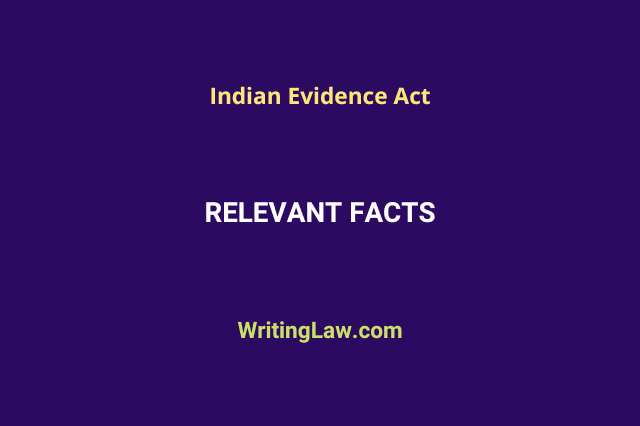
The Indian Evidence Act helps us understand what counts as a “fact” in the legal world. It doesn’t just include physical things; it also looks at what happens in the world and what people think and feel inside their minds. In simpler terms, it sets the rules for considering different types of information in legal matters.
This law note will help you understand the concept of relevant facts under the Indian Evidence Act.
What Is Relevancy?
Relevancy is the broader scope. The facts must connect in a way that makes sense and helps the court conclude the case. Facts might be linked by:
- Cause and effect: A witness sees Z arguing with B, and B is found injured – relevant!
- Common experience: Someone buys life insurance a week before dying – suspicious and relevant!
- Correlation: Sales of raincoats increase when the weather forecast predicts rain – not necessarily relevant to a specific lawsuit.
The court has some discretion in judging relevancy, like deciding which boxes in the attic to open first.
Related: Difference Between Relevant Facts and Relevancy of Facts
Act Influenced in Relevancy
Section 3 of the Indian Evidence Act of 1872 defines “evidence.” It includes remarks or documents produced before the court by witnesses addressing the main issue under investigation. The Indian Evidence Act does not distinguish between admissibility and relevancy.
Section 5 of the Indian Evidence Act states that evidence may be used in any judicial matter to demonstrate the presence or absence of facts in dispute and additional facts deemed significant as described below, but not beyond. The decision of relevance is based on logic and likelihood considerations, which guide the admissibility of evidence.
Section 6 of the Indian Evidence Act states that facts that are not directly under examination but are connected with a relevant fact to the extent that they form part of the same transaction, whether they occurred concurrently or at various times and places, are likewise relevant. This includes actions and omissions, which do not have to be continuous but should add to the overall context of the transaction.
Section 6 of the Act defines “Res Gestae” as a legal notion that denotes an action or event.
Sections 6 to 16 cover facts related to the topic, such as causality, motive, and direct significance.
Sections 17 to 31 of the Act govern confessions, whereas sections 40 to 44 govern the applicability of court rulings.
Sections 45 to 51 discuss when third-party opinions are relevant.
Sections 52 to 55 of the Act further identify scenarios in which a person’s character is significant.
If a link between the facts does not exist, as stated above, the fact is regarded as irrelevant. A court may, however, reject relevant evidence if the possible hazards outweigh the probative value of the evidence. Such hazards include unfair bias, confusion of issues, misleading the jury, unnecessary delays, or inappropriate inclusion of cumulative evidence.
Difference Between Relevancy and Admissibility
This section examines the distinctions between admissibility and relevancy, highlighting some of their distinctive features.
Definition of Relevancy and Admissibility
- Relevance: The logical and consequential connection between facts is referred to as relevance, and the existence or non-existence of one set of facts is most likely dependent on the regular course of events or human behaviour. It is based on the intrinsic relationship of facts, emphasising their logical connectedness.
- Admissibility: On the other hand, admissibility refers to the legal significance of facts proclaimed under the Indian Evidence Act. It refers to the admissibility of evidence in court, which is established by obedience to legal norms rather than inherent logical links.
Case – Ram Bihari v State of Bihar [(1998) 4 SCC 517]: The Supreme Court noted that while admissibility and relevancy are synonymous in this instance, their legal meanings differ, and the admissible facts might not be relevant.
Basis of Relevancy and Admissibility
- Relevance: The basis for determining relevancy is reasoning and human experience. It is founded on the connection of facts and the awareness that certain facts increase or decrease the likelihood of the existence of others.
- Admissibility: Legal principles govern admissibility. It is assessed by their compliance with the legal requirements stated in the Evidence Act rather than their inherent link between facts.
Legal Framework
- Relevance: Provisions related to relevancy are covered in detail in sections 5 to 55 of the Indian Evidence Act. These sections describe the many ways in which facts can be related and serve as the foundation for determining relevance.
- Admissibility: Section 56 of the Indian Evidence Act primarily discusses the legal context for admissibility. This section defines the standards determining whether evidence is legally admissible in a court of law.
Conclusion
The judiciary uses the law of evidence as a crucial instrument to help it filter through and weave together the large amount of information that each case offers. Evidence that is admissible and has evidentiary value is limited to that which is covered under the Indian Evidence Act of 1872.
In addition to saving the court’s time, this enables the court to obtain the pertinent and accurate evidence it needs to decide a matter easily. The Indian Evidence Act contains an interpretation and definitions in section 3 that explains words and ideas important for understanding the Act and evidence law.
- 13 Characteristics of a Company Under the Companies Act - 5th March 2024
- Lee vs Lee’s Air Farming Ltd – Case Explained - 5th March 2024
- Relevant Facts Under the Indian Evidence Act - 14th January 2024







